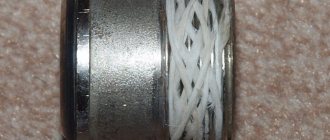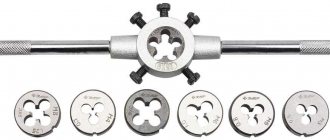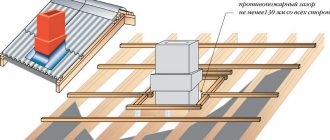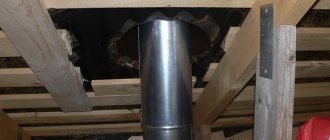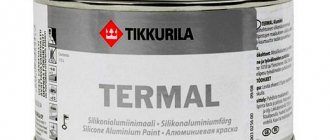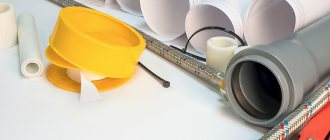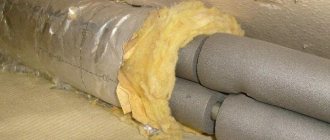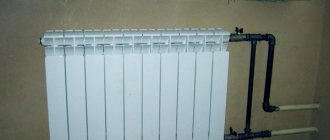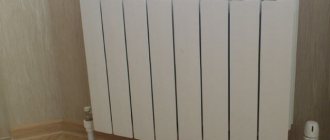How to wind FUM tape correctly - features of processing connections
When assembling a pipeline and installing various plumbing equipment, it is necessary to firmly seal the joints of pipe parts in order to avoid water or gas leaks. There are various materials for this. One of the most popular tools for sealing is FUM tape. Its use has its own subtleties and nuances, so you need to know how to wind FUM tape correctly so that no problems arise during the installation process.
Advantages of fum tape
Fum tape is intended for sealing threaded, flange and nipple connections. Its main component is fluoroplastic, it is resistant to acids, solvents, and alkalis. Well suited for systems with aggressive environments. Provides reliable sealing of joints that are under constant pressure. It does not emit toxic substances and does not cause any harm to humans, therefore it is used in the food and medical industries.
Fum tape is practical for use in all areas of industry due to its advantages:
- Thermal resistance. The tape is used in a wide range of applications as it can withstand temperatures ranging from -70 to +260 °C. It is wound onto cold and hot water, gas and heating pipes.
- Impact resistance. It is not destroyed by exposure to chemical, acidic and alkaline environments. Not subject to destruction by microbes. Can last longer than flax tow.
- Increased resistance to friction. Does not strip threads, reduces friction of connected elements.
- Safety. The material does not burn and is not explosive.
- Durability. Sealing with fum tape lasts more than 10 years, this is a better indicator than other sealing materials.
- A wide range of. The tape is divided by grade, thickness and width. This is a cheap material, so it is available to everyone.
The main advantage of fum tape is that it has high elasticity and density, convenient and practical to use.
Where is it used?
Due to its properties and characteristics, FUM tape is used in most situations where sealing treatment is required.
- Water pipes . The most important thing that FUM tape is used for is sealing water connections. The material is water-repellent, which makes it almost indispensable for fastening water pipes and parts during the assembly and installation of equipment.
- Gas pipeline . The film can be made gas-tight, and it can be used to install gas appliances and meters. However, not every FUM tape is suitable for this purpose; you need to purchase a specialized tape for gas.
- Technique . The material is characterized by resistance to various types of influences, therefore it is actively used to repair internal mechanisms of cars and various technical devices.
Definition of fum tape
The full name of the fumlenta is fluoroplastic sealing tape. This is a product that is used to seal the various connections mentioned above.
Production and varieties
Manufacture is carried out using a fluoroplastic rope. The film is rolled out to a certain thickness. After all, the sealing material is sold in the form of tape in various sizes. The tape itself is wound on a reel. I use the product during the installation of structures that are under a certain pressure. These structures are water supply, gas supply or central heating system.
The product is a deformable filler, as well as a thread lubricant - this makes sealing better. This product is practically not used in systems that are responsible for heating using hot water. However, thanks to this sealing, heat is retained.
Let's look at the varieties of this product:
- Fum-1. This type is intended to provide tightness to pipelines. These pipelines must work in conjunction with an aggressive environment. Contains lubricant. Vaseline oil acts as a lubricant.
- Fum-2. This variety is used for structures that have contact with strong oxidizing agents. Therefore, it does not contain lubricant.
- Fum-3. Intended for structures in contact with clean media. The composition also does not contain lubricant.
This tape is also divided into types according to another criterion - size. Thickness, width and length vary. Thickness can start from 0.075 and reach up to 0.25 millimeters. The initial width is ten millimeters. The length starts from one hundred centimeters.
You can also find specially designed gas tape on store shelves, which is yellow in color. The maximum thickness of this material is 0.25 millimeters. This tape is intended for gas supply - a system that operates under low pressure. But for gas supply, you can also use regular fum tape.
Properties and characteristics of plumbing tape
Let's talk about the main properties and characteristics of this product. Fum tape technical characteristics:
- Fumlenta has a low level of friction. The tapes are slippery, which makes it easier to seal different joints. Fum tape improves fit and compaction.
- Plumbing tape has a high level of heat resistance (resistance to different temperatures). This suggests that this material can withstand high temperatures - more than 300 degrees Celsius. However, they can be used at a temperature of 250 degrees Celsius and no more. Since at higher temperatures toxic substances are formed that can harm the human body. Tapes are also excellent electrical insulators.
- The product has excellent strength and ductility. The material has a high level of resistance to alkalis and acids. The tape is quite inert to various chemicals. Also, plumbing tape has great resistance to rotting.
- There is inertness to chemical and biological substances. Resistance to alkalis and acids is shown.
These are the characteristics this product has.
Before this sealing material appeared on the construction market, tow for plumbing was used for this procedure. Plumbing tow is flax fiber. However, it was necessary to additionally use oil paint for sealing. Oil paint was used for lubrication.
Flax plumbing fibers are also used today along with other products for sealing a variety of joints. However, instead of oil paint, a special sealing paste is used, which is applied from the top of the winding. Specially formulated sealing paste gives the system strength, reliability and durability.
Thanks to this sealing substance, reliable protection against rotting of the structure is formed. Previously, plumbing tow with the additional use of oil paint was difficult to dismantle; thanks to the paste, this can be done easily if necessary.
Method of winding sanitary tow
In order to prevent flax from sliding along the thread, notches are made on it.
If the thread does not have notches, then you should make them yourself. If this is not done, the linen sealing material will slip off.
Before winding, you need to separate a small strand of flax. Determining the length and thickness depends on the diameter of the gas or water pipe. The winding must be tight. The fibers are wound in the direction of the thread. And the end of the plumbing tow, which turns out to be free, must be fixed with a finger.
Next, you need to put the turns into a strand, which is a guide. Remember that excellent sealing is achieved due to the ideal layer thickness of the wound material. Calculating the ideal thickness of a product on your own is quite difficult; this requires some experience. To wind the product, you also need the help of a specialist.
Pros and cons of using
The main advantage of choosing tape is its availability. FUM is sold at a low price, cheaper than flax tow and most other sealants used in plumbing.
The material is characterized by ease of installation. With proper skill, winding the tape occurs in a matter of seconds, but for this you should practice winding it on connections of different diameters for some time.
An important advantage of using tape is that the parts fastened with it can be easily disassembled. The connections do not freeze tightly; they can be disassembled even years after installation.
The main disadvantage of the material is that it is not the most reliable of seals, therefore, as a rule, it is not used for industrial installation. However, for household repairs the hermetic properties of FUM are quite sufficient.
Another disadvantage is that the tape often protrudes outward from the joints, so the pipes may look sloppy because of this.
If this is your first time working with fum tape or the connections on it do not work out and leak quickly, use our short guide. In just 2 minutes you will learn how to properly wind fum tape onto a thread and avoid common mistakes.
Preparation
Let's start with the fact that no one will ever say exactly how many turns of the fum tape should be made. For each connection everything is individual and depends both on the diameter of the thread, the thread stroke, and on the size of the tape itself. Fum tape varies in width and thickness. The only thing that can be guaranteed is that the thicker the tape, the fewer turns required.
Preparation for assembling the connection usually begins with the purchase of several FUM coils. This is necessary to experimentally determine the number of turns of tape and the size for a specific thread. In addition, before winding the fum tape onto the thread, you need to fill your hand and make several idle windings.
Fum tape for water and gas is tested for strength by a simple method - stretching. The thread should not tear like paper, but maintain sufficient tension equal to 2-3 turns. The elasticity of the thread proves its quality.
For connections on the FUM, choose a clean thread with notches or free of previous seals. If the manufacturer did not apply them, do it yourself. The notches will prevent the tape from slipping and protect against leakage.
Winding
So, in front of you are several rolls of tape and a thread. There are two options that people like to use when winding fum tape:
First. The entire width if the tape matches the thread size (i.e. the width of the thread). In this case, the tape is slightly pulled and pressed into the thread so that it falls into each turn. The thread should be completely hidden under the tape, and the FUM should tightly fit the surface to be sealed. The connection is first assembled by hand, and then tightened with a wrench with force.
Second. In this case, the fum tape is wound according to the type of thread. Suitable for connections on small threads or when using narrow tape. The FUM is stretched into a thread and placed clockwise into each cavity until the thread is hidden. The turns can be made crosswise or move smoothly along the thread and back. Twisting is done in the same way - with your hands and a key.
We can only say approximately how much fum tape to wind. For a 1 inch thread and a tape 19 mm wide and 0.2 mm thick, approximately 5 turns are sufficient. But it’s not a fact that exactly such a tape will be at your fingertips. Therefore, be guided by the dimensions of the purchased material and parts.
If we compare it with compaction on flax, then the fum tape should have more revolutions, since it shrinks.
It is more convenient to use fum tape than flax, but there are enough subtleties. Without experience, a quality connection cannot be achieved. We advise beginners to either abandon FUM altogether and use plumbing thread, or seal simple areas where a possible leak will not lead to large-scale consequences.
Scope of application - where and how to use fum tape
This sealant is perfect for:
- Replacing gaskets and O-rings
- Temporary connections
- Installation of faucets, shower hoses and shower heads
- Plastic; fine thread
An alternative to fum tape is plumbing thread. It is universal, easy to wind, and allows you to adjust the connection without losing the tightness. Taking into account its economical consumption, the cost of one connection on thread and tape is approximately the same.
You can buy high-quality sealing thread directly from the manufacturer right now on our website at an affordable price.
Specifications
Let's consider the technical characteristics of the FUM tape, which determine its properties:
- the material is characterized by resistance to damage;
- has plasticity;
- retains its properties for a long time and does not need regular replacement;
- is environmentally friendly and does not emit harmful substances;
- heat-resistant, able to withstand a wide range of temperatures;
- the thickness is only two tenths of a millimeter;
- has dielectric properties and gas impermeability;
- elastic, capable of stretching almost twice its original length.
Using FUM for water connections
The use of sealed film for water connections has certain advantages compared, for example, with the use of flax tow and sealant
When using sealant, depending on its type, the connection can be sealed almost tightly, and if dismantling is necessary, the pipes will take a long time to disassemble.
The advantage of using FUM tape for water is that it does not interfere with the dismantling of pipes, is sufficiently waterproof and is easier to use. It can also be used together with flax as an additional sealant.
FUM tape: how to wind it correctly
Any plumber or unskilled homeowner can easily wrap flax tow or plumbing thread around a ball valve, faucet eccentric, or radiator adapter coupling, and successfully secure them in the right places. In this case, the thickness of the layer does not play a decisive role (if there is a shortage of insulator, it can always be added) and the only rule that should be followed is to screw the material only along the thread to avoid it unwinding during revolutions.
With FUM tape, the situation is a little more complicated - with a large layer, the winding will move in the opposite direction and can partially clog the pipeline channel (there are many examples of incorrect winding in videos from the Internet). Therefore, knowing how many turns of FUM tape need to be wound is an important point, and proper installation of joints on fluoroplastic sealant requires practice and some skills.
Before winding the FUM tape, you need to clean the threads from debris, dirt and rusty deposits (you can use solvents or gasoline), then work is carried out in the following sequence:
- Without removing it from the reel, press the edge of the tape with your finger and wind it clockwise onto the thread with a slight tension, avoiding twisting. It is advisable to use tape with a width equal to the length of the thread. The number of layers depends on many factors - the thickness of the tape, the material of the fittings, their diameters, the quality of workmanship (the size of the gaps), usually the standard number of turns does not exceed three to four, but can reach up to twenty.
- Next, the tape is pressed with force with your fingers in a circular motion; the relief of the thread should be visible under its surface.
- After winding, the tape is cut off by tension - this method is better than trimming, as it compacts the wound layers more tightly and makes the outer edge narrower.
Important: If, when using FUM tape, the connection turns out to be leaky, dismantling it and adding a few turns will not work - the strip is cut through during disassembly and is irreparably damaged, you will have to wind more turns again.
It should be understood that FUM tape is not a complete replacement for flax fiber - it is designed for use in connections on threads with elastic or blunt edges (modern plumbing fittings according to Western standards, polymer fittings), where its surface cannot be cut through. For heating systems with steel pipes or in large-diameter utility pipelines, the use of flax tow does not yet have a worthy replacement in the form of FUM in terms of efficiency, availability and low cost of the material.
Using FUM for a gas pipeline
To fasten gas pipeline parts and install gas equipment, you should use only special FUM tape for gas. It must be supplied with a certificate of conformity confirming its suitability for use on gas pipes.
The special film for gas is yellow. It is made wider - up to two centimeters in width.
The use of the material is possible only when sealing can only be achieved using a sealant. In the case of rubber hoses, as well as metal hoses, the sealing function is provided by a special gasket. In this case, the additional seal will not add tightness to the connection, and may even break it, as it will interfere with the tight fit of the gasket.
How to wind the seal correctly and how much
To obtain the most reliable connection using FUM tape, you should follow a number of simple rules:
- Before winding the material, you must thoroughly clean the surface of the joint from rust and dirt, and then degrease it with solvent or gasoline. Further actions are carried out only after the joint has dried.
- The FUM tape is wound onto the external thread along its course, that is, clockwise. The width of the material is selected depending on the width of the threaded connection. The edges of the seal must not cover the inner diameter of the pipe.
FUM tape is applied along the thread
- The tape should be applied tightly enough and with little force, this will give the connection tightness and strength.
- The number of layers is calculated depending on the diameter of the pipe and is directly proportional to it. For example, for a pipe with a diameter of 30–40 mm, 4 layers of FUM tape will be required, and for a pipe with a diameter of 20–30 mm, 3 layers will be sufficient.
- The end of the material should be brought out in such a way as not to create obstacles for screwing on the connecting elements.
How to wind tape
In fact, to figure out how to properly wind FUM tape onto a thread, you do not need to have any special skills. However, certain operating features should be taken into account in order to protect connections from leaks.
Before winding FUM tape, you must first thoroughly clean the parts. All joints must be treated with a solvent and dried to prevent debris from getting under the tape.
The film is wound according to the direction in which the part is twisted. For strength and reliability, the material needs to be stretched a little. However, you should not overdo it; control the tension force so as not to accidentally tear the film. The end of the film should be brought out - it should not interfere with the twisting of the part.
The film must be wound in several layers. At the same time, the number of layers directly depends on the size of the connection - the wider it is, the denser the winding should be. As a rule, four turns are enough, but on wide pipes their number can reach up to two dozen.
Pull the tape so that you can clearly feel the relief underneath it. It is best to break the tape not by cutting, but by tensioning it - this way you will additionally stretch the material and narrow the edge of the tape.
How to wind FUM tape onto a thread?
PTFE tape is quite easy to use and provides reliable sealing of threaded connections. However, this also has its own nuances that must be taken into account when winding FUM tape onto a thread.
.
In order to know how to properly wind FUM tape onto a thread
, it is necessary to consider the basic rules that should be followed when working with this material:
- It is necessary to choose the right material - the thickness of the tape depends on the thread pitch: the finer the pitch, the greater the thickness of the tape should be. In this case, after compaction, the threaded connection must be screwed in with force, otherwise an additional layer of material must be wound.
- Before screwing the FUM tape onto the thread, it must be cleaned of rust, dirt and residues of other sealants. After cleaning, the thread surface should be treated with gasoline.
- Winding of the FUM tape onto the thread is carried out along its course, while the seal is screwed under tension.
- After finishing winding the seal onto the thread, it should be lightly compressed with your fingers.
In order to determine how many turns of FUM tape need to be wound onto the thread
, it is necessary to measure the length of the thread and perform the appropriate calculation based on the width of the seal. However, in most cases the number of turns is determined on site. Typically, 9–10 turns are required to seal threaded connections.
Threaded connections of water and gas systems have been known for more than three hundred years, having once served as an impetus for improving the quality and speed of installation. A particularly important point has always been, and remains to this day, ensuring tightness at the connection point.
Traditionally this was achieved using flax fiber
and thick grated
oil paint
. The disadvantage of this method was the loss of the ability to disassemble the joint after a short period of operation of the system. To preserve expensive fittings, they used burning of the sealing winding with an open flame.
And only in the middle of the last century, FUM tape for gas pipes was developed, made from Teflon by rolling out a cord
. The abbreviation FUM means fluoroplastic sealing material.
Other seal options
Of course, FUM tape is not the only existing option for sealing joints. Among others, linen tow should be highlighted, along with which various types of sealants, as well as plumbing thread, are used to fasten pipe parts. Let's consider their advantages and disadvantages in comparison with FUM.
Flax tow
Linen is also one of the most popular materials. Just like FUM, it is customary to wrap tow in a dense layer.
It is important to wind the tow carefully and tightly, filling the thread completely along the turns. The outside of the fibers is additionally coated with paint or sealant. This leads to the main disadvantage of this material. It should be borne in mind that if paint is used, the connections cannot be dismantled and the pipes will be unsuitable for repair.
Also, the disadvantage of this material is its relative fragility. Unlike tape, flax is subject to gradual decomposition under the influence of moisture.
The main advantages of tow in comparison with FUM are:
- Adjustability. After winding and securing the connection, it is possible to unscrew it at a slight angle without loss of tightness and the need to replace the sealing material.
- Reliable sealing, high degree of tightness and ability to absorb liquid.
- High resistance to various types of physical influences.
- Easy to disassemble the connection.
If you have to choose what is better to use – ribbon or linen tow, then there is no definite answer. As a rule, it is recommended to use tow for intermediate pipeline connections. The tape is more suitable for securing taps, meters and mixers.
Sealants
When using flax tow, for a better fit and seal, the joint is additionally treated with a liquid sealant.
Sealants significantly improve the tightness of the thread, thereby increasing the tightness of the connection. In addition, they provide stronger protection against physical damage. This is especially true in pipelines, since pipes are constantly exposed to internal influences.
However, the main disadvantage of using sealants follows from the above. They hold the joints together very tightly, so dismantling the structure if the need arises will be very difficult. The connection will have to be unsoldered, and it is not a fact that after this they will be suitable for re-installation. The sealant hardens when exposed to air and works like superglue.
Sealants come in different strengths. They fall into two main categories.
- Blue sealant is characterized by medium strength. When using it, it is still possible to disassemble the structure without damage, but it is still problematic. To loosen the connection a little, you will have to put in a lot of effort.
- Red sealants are stronger than blue ones, so if they are used, it is absolutely impossible to disassemble the structure without resorting to artificial heating. It should be used only in sections of the pipeline subject to strong vibrations in order to maximally strengthen the connections in these places.
Plumbing thread
Plumbing thread is an advanced caulking tool. It is already impregnated with a sealing compound, so there is no need to use liquid sealants.
The fibers of the thread do not dry out under the influence of high temperatures and do not deteriorate from contact with liquid. When disassembling pipes, it is not necessary to clear the threads from the connections. The material is easily and quickly wound in a couple of dozen turns.
The thread allows the connections to withstand strong pressure without creating difficulties during dismantling. In general, this is a more reliable tool for sealing joints, but it also costs more than FUM or tow.
How do professionals wrap tape around threads?
To understand how to use fum tape, you do not need to have the special skills of a mechanic or repairman. Just observe the following nuances:
- you should wind slowly, tightly and clockwise;
- pull the tape slightly, and it will not sag or dangle (the main thing is not to apply unnecessary force, otherwise the material will tear);
- Place the end of the winding so that it does not interfere with the winding of the connecting element.
The tape should be wound in several layers, the number of which depends on the diameter of the thread. So, how long to reel fum tape?
- diameter 15-25 mm – 3 layers;
- diameter 25-40 mm – 4 layers, etc.
These parameters are correct only in the case of high-quality material, which costs an order of magnitude more. If you decide to save money, then be prepared to spend exactly 2 times more fumig material.
Advice! Experienced installers recommend using exclusively tape for plastic and metal-plastic pipes, which are used to install plumbing and heating in homes today.
Briefly about the main thing
FUM tape is one of the popular and effective sealing options. It is affordable, easy to use, and does not create problems during subsequent repairs.
There are several simple rules on how to wind FUM tape onto a thread:
- the winding area must be cleaned;
- the tape is wound along the thread - how the nut will move along it;
- When winding the tape, you need to tighten it a little;
- Usually four layers are enough, but sometimes more are required;
- After winding the tape, the thread relief should be palpable.
Source
We wind the FUM tape
Rules for winding FUM tape
- Before winding plumbing tape onto the thread, it is necessary to prepare the surface, remove rust and debris. It is advisable to degrease with gasoline or solvent.
- The thread must be undamaged.
- The working base must be dry.
- You need to determine the type of thread , right-handed or left-handed (a right-handed thread is one that twists clockwise). We wind the thread clockwise on the right on the left thread.
- During winding, the fumka needs to be pulled tightly.
- The tape should completely cover the threads.
- At the end of the work, the protruding tape is cut off with a knife , and the processed thread thoroughly pressed down with your fingers.
- If you need to seal a wide thread, but only a narrow thread is available, you can first stretch the tape into a thread, wrap each thread step, and then wind the tape across the entire width of the thread.
- The FUM tape is wound in one piece .
- Not reusable.
- is wound overlapping , from one edge of the thread to the other edge.
How to wind FUM tape onto a thread
- Preparing the thread surface clean from dust, preferably degrease.
- For right hand thread we shake the fumka clockwise.
- This is what happens in case of incorrect winding fumki.
- Fumku we begin to wind, stepping back a little from the edge of the thread, approximately one to two turns.
- To seal the winding, the tape should be wind in tension.
- Number of turns fumki depends on the thread diameter and the parameters of the FUM tape.
- Compound winds up at first manually all the way, A after with a wrench, with a force that meets the requirements for a given thread diameter.
Fumlent for water how to use. How to wind fum tape correctly? Tips and tricks
A threaded, flanged or nipple connection requires a seal to prevent leaks during further operation. A universal fluorine-containing film - fumlenta - has replaced the traditional tow, known to plumbers since time immemorial. Now they use modern fum tape, which significantly improves the quality of joints of pipelines and utility systems.
Note : fum tape is suitable for plastic plumbing equipment, where it shows a 100% result in sealing joints.
What is fum tape?
Fum or fluoroplastic sealant is a synthetic material produced in the form of a tape of transparent, but often matte color. It contains fluorine and is therefore tolerant to mechanical and thermal stress. But to understand how to wind fum tape correctly, you need to understand its varieties:
- industrial, contains 20% lubricant in the form of petroleum jelly;
- household, inexpensive analogue of the previous one;
- for systems with strong oxidizing agents;
- for systems with particularly clean environments.
Important! Fum tape helps in sealing threaded and nipple connections in cold and hot water supply systems, but the maximum pressure in them should not exceed 9.8 MPa.
Properties and technical specifications
The tape is made of polytetrafluoroethylene or fluoroplastic. The winding made from it has unique properties:
- Stable in the temperature range – from -60 to +200°C;
- Does not absorb water and other liquids:
- Resistant to chemical compounds;
- Neutral reaction to technical lubricants and construction emulsions;
- Resistant to the formation of fungi and mold;
- Does not react to atmospheric influences;
- Withstands system pressure up to 100 atmospheres, resistant to water hammer and pressure drops;
- Does not crumble at low temperatures and does not melt at high temperatures;
- Does not age - service life is equal to the service life of the structure.
Advantages and disadvantages
The advantages of the winding include:
- The first difference from tow is that fumlenta does not absorb water. Therefore, the joining does not require additional sealing in the form of paint or putty;
- Ease of use - the seal is packaged in small reels, from which it is easy to screw directly onto the thread;
- Aesthetic processing - the material does not protrude beyond the edges, as happens with tow. In addition, the tape is produced in colors that match the colors of plastic pipes and blends into the general background;
- Linen tow becomes unusable over time and requires replacement, but fluoroplastic does not collapse and lasts as long as a fitting or siphon;
- Easy dismantling in case of replacement of the structure. The winding is simply removed without additional stripping;
- After winding the seal, no significant effort is required to connect the parts;
- Widespread - it can always be purchased in several widths and thicknesses in any construction market.
There are minor disadvantages:
- Not suitable for triangular metal steel threads, as the material may be damaged by sharp edges and will not function as a sealant;
- The excess winding is not compacted like traditional tow, so you need to dose the winding turns. Usually this is 3-10 revolutions;
- The seal is not suitable for equipment that produces vibration during operation. During operation, shaking deprives the fluoroplastic of its inherent properties, breaking the tightness.
Advantages and disadvantages over tow
Flax fiber remains one of the widely used materials for sealing joints on threads, but in many cases it is being replaced by FUM tape due to the following advantages:
- Unlike tow, which is saturated with water and requires additional protection (painting, putty), the fluoroplastic strip is waterproof and does not require additional consumables during installation.
- Sealing with fluoroplastic tape is characterized by simplicity and high speed of work.
- It is almost impossible to detect joints using flax fiber that have an aesthetic appearance - tow often protrudes beyond the dimensions of the joints, being located on the surface, has an inaccurate shape and is painted in conspicuous colors. The connection with the FUM is usually hidden under the fittings and is invisible to the eye; if necessary, it can be easily cut off or left on a light plastic pipeline without disturbing the decorative effect.
- Linen is a natural material and, when saturated with moisture, is susceptible to rotting and destruction; fluoroplastic can work in the system for decades without losing its physical and chemical parameters.
- For the reasons given above (painting after winding), the connection with a fluoroplastic insulator, unlike flax tow, is quick-removable - easy to dismantle without further work on cleaning the threads and surfaces of the parts being connected.
- When sealing tow, it is necessary to exert significant physical effort using plumbing wrenches - this can lead to destruction of the surface of fittings, adapter couplings, and union nuts. Due to its plasticity, when using fluoroplastic tapes, the applied forces are much less and allow you to connect parts even by hand.
- The commercial advantages of FUM tape should also be noted - it is easily accessible, it can be purchased at any building materials store or on the market, and the cost is comparable to the price of flax tow.
Rice. 3 Metric and pipe threads
Despite the rather significant advantages, FUM tape has not completely replaced tow for the following reasons:
- The material has insufficient mechanical strength, that is, when used on a metal thread, its surface can be easily damaged (cut) by the sharp edges of the teeth during winding - as a result, the tightness will be broken and the connection will begin to leak water. This drawback limits the use of FUM tape, which is not recommended for use on triangular metal threads with sharp teeth (Fig. 3); the most suitable types are pipe, trapezoidal and any type on plastic products made of polymers.
- The tape is more demanding on the thickness of the winding layer than flax tow; if there is an excess, the surface of the fluoroplastic sealant breaks, while the flax simply compacts.
- Despite its high heat resistance, FUM tape is not recommended for use in heating systems with steel pipes - due to thermal expansion, it is strongly compressed or squeezed out of the thread, and when cooled, it does not completely seal the connection, resulting in a leak.
- FUM should not be used when joining fittings that are subject to vibration during operation.
Note: When using FUM tapes, you must understand the following: it is more suitable for connecting threaded fittings made of polymers, with good skills - with metal trapezoidal and rounded threads, and is excluded when installing steel pipelines in which the threads are triangular in shape and applied using technology Soviet times or independently with dies.
Which is better linen or fum tape for water?
A professional plumber always has different types of seals on hand:
- fum tape;
- flax and sanitary paste;
- threads (type “Tangit”);
- anaerobic sealant.
The craftsmen know that all seals, when installed correctly, perform their task 100%. But to do this you need to know how to use it, what to use and under what circumstances. The abundance of modern sealing materials has displaced flax from its leading position. But not all masters agree with this.
The fact is that in past decades flax was used together with red lead or oil paint. Today – with Unipak plumbing sealing paste. Its main task is to prevent the flax from drying out and rotting. Connections made using these materials can be adjusted (axially shifted) by 45° without loss of tightness.
- inexpensive price;
- suitable for sealing threads of any diameter;
- the connection will be good regardless of whether the base surface is wet or dirty.
The disadvantage is that any connection made with flax subsequently requires additional twisting and tightening. Another “minus” of flax is that it is not very convenient to work with: the fibers delaminate and cling to clothing and the tools and materials used.
Linen or FUM tape
It’s impossible to say for sure which is better , linen or fumka . Both one and the other material have their own advantages and disadvantages over each other.
- Durability . Compared to linen material, or tow as it is also called, FUM tape does not age and does not undergo biological decomposition.
- Ability to expand. In a humid environment, tow expands and fills the entire space between the thread pitch, eliminating minor flaws during installation. Due to expansion, flax is better used when installing heating .
- Dependence on diameter. It is better to use the gun for small diameters up to 1 inch , with thin-bodied pipes and fittings. On the contrary, it is preferable to use tow for large diameters.
- Versatility. Both materials are inert to alkalis and acids.
- Preparation. For tow , no special surface preparation ; it can eliminate even minor damage to the thread, unlike a foam tool.
- Availability. Both materials can be found in any hardware store, the cost of both windings is low.
- Purity. Working with a fumka is much cleaner and more pleasant. After all, for tow to be more effective, you need to use a special paste and get your hands dirty.
- Possibility of adjustment. Due to the above-mentioned expansion ability, the joints on the tow can be adjusted in any direction.
- Temperature Range. Both materials cope at temperatures up to + 300°C for fumka, and up to + 140°C for tow.
A simple way to wind on a thread
Technically, the seal is a thin, narrow strip wound on a bobbin. Shades – white and cream. The purpose of the winding is not to leave a gap for water or other liquid to leak. Keep in mind that standard threads always run clockwise from left to right.
Note: Using the tape for the first time, it is better to make a test winding to see how the material behaves and determine the number of turns in a given area.
To wrap the joint, the end of the tape is released and attached to the thread. Keep the reel in the winding direction so that the fuse is constantly tensioned counterclockwise. It is constantly tightened, evenly shifting it by half so that there is a good overlap with the previous layer.
The second stage is to rub the finished winding onto the base with your fingers so that it literally eats into the thread and the ribs appear. It is so easy to screw on the second half of the structure, and the tape backing will ensure reliable tightness of the connection.
Important! The tape should fit tightly around the pipe, not bubble, and lie smoothly.
If this is your first time working with fum tape or the connections on it do not work out and leak quickly, use our short guide. In just 2 minutes you will learn how to properly wind fum tape onto a thread and avoid common mistakes.
Preparation
Let's start with the fact that no one will ever say exactly how many turns of the fum tape should be made. For each connection everything is individual and depends both on the diameter of the thread, the thread stroke, and on the size of the tape itself. Fum tape varies in width and thickness. The only thing that can be guaranteed is that the thicker the tape, the fewer turns required.
Thread sealing with FUM tape
This video shows how to seal a thread with fum tape. To begin with, it must be said that sealing threads with fum tape is the most difficult for beginners. It is with fum tape that leaks most often occur in novice craftsmen, or in people who do plumbing at home. Let's figure out why.
It is impossible to say exactly how long to wind fum tapes. Everything is individual. Tapes come in different thicknesses and widths. You need to buy a couple of skeins and try to wind a few threads just at idle, in order to practice.
There are thin and thick tapes. One can be taken for large threads, the other for small ones, but they are also divided into widths. One tape can be 12 millimeters wide, and the second 19 millimeters wide. In addition to width, the tape has thickness: 0.1 mm, 0.75 mm, 0.12 mm and 0.2 mm - the thickest tape that is often used. That is, the tapes are different in thickness and width, and it is very difficult to say how much to wind the tapes onto the thread, because it depends on many factors. Therefore, it is only shown how to wind, how it should look. Based on the thickness and width of the existing tape, you can train and get the result that needs to be achieved, that is, the tightness of the connection. When choosing a fum tape, pay attention to how it stretches; if it doesn’t stretch and immediately breaks, then the tape is bad. It breaks in any case, but first it should stretch, and not immediately tear.
What causes leaks?
Due to errors in winding. If you wind the entire width, then the tape needs to be pulled so that it falls into each turn. Make sure that it engages, tighten it by hand until the end, then with a wrench.
For large threads (1''), you can use 0.2 mm tape and wrap it across the entire width. You can wind a thin tape (0.075, 0.12, or 0.1) onto the same thread, stretch it into a thread and place it in each turn, and end with the entire width so that the thread does not unravel.
If we are talking about winding fum tape on a thread, just on a thread, then it is advised not to use a thickness less than 0.1 mm. This is not convenient, you need a lot of it, and it costs a lot. Thin tape can be used, for example, on 1/4 inch threads. It is soft, thin, and shrinks easily. And when tightening, for example, a pressure gauge or pressure switch, the thread will not be damaged. Please note again: it was wound higher than the thread, that is, the entire thread was hidden, each turn was filled, wound a little on top and tightened. Otherwise, it will leak under high pressure.
In order to seal threads sometimes at home, in everyday life, it is still recommended to have a thread. It’s more convenient to work with thread - it’s harder to make a mistake. You can wind it randomly as you like, and the connection will not leak. You will have to practice with fum tape. But if you are engaged in plumbing services, then, of course, it is better to have tape with you.
Where to use fum tape?
Firstly, fum tape can be used on plastic fittings. It doesn’t matter whether we twist plastic with plastic, or metal thread with plastic, you can always wrap fum tape on the thread. Due to the fact that it is soft, that is... Yes, by the way, in the case of plastic threads, many wind the entire width. I pulled it, wound it, wound it a little more. That's it, let's tighten it up.
The following is where fum tape is used. If the spout needs to be repaired. It often happens on faucets that the spout leaks at the point where it connects to the faucet. There is a rubber gasket there, which, of course, is better to change and the problem will be resolved. But it often happens that there is simply no gasket, but at home there is fum tape 0.1 mm thick. You need to take it, stretch it into a thread, and wind something like this gasket. Then the entire width from above. They tore it off, pressed it, that’s it. Insert the spout into the mixer and the leaks are gone.
Further. If you need to change the faucet axle, or the gasket on the faucet has leaked, but there is no other one at hand to replace it.
Following. For example, there is an American cone. Despite the fact that the American one is considered self-sufficient and does not need to be sealed in any way, it is still better to wind the fum tapes once than to assemble them without it, start the riser, look, and find that the connection is leaking. Therefore, it is better to immediately take a 0.075 mm fum tape and wind 4-5 turns.
Again. Wind in the same way as flax. Clamp the first turn, overlap it, and then pull it into each turn. Put it in each turn and come back. A couple more turns in the middle, then the entire width on top 2-3 more times. Twist. Everything is wrapped up, all that remains is to clean it up.
So, where to use fum tape? On plastic threads, sometimes on thin and small metal threads. But mainly for repairing rubber O-rings and gaskets. If at the moment there is nowhere to buy this gasket, but it’s time to turn on the water. In all other cases, the fum tape is usually not wound. And that's why.
Adjustment without loss of tightness is impossible. This means that if you need to unscrew a twisted fitting a little, then, unlike thread or flax, this cannot be done without losing the tightness, and this is very important.
Secondly, many people simply don’t like to wind fum tape. The thread is much more convenient and easier to wind. In the opinion of many, it is generally the easiest to wind.
And third is the cost of the fum tape. Of course, it may immediately seem that fum tape is much cheaper than thread, but in fact, its consumption turns out that fum tape will need to be wound much more for the same diameter than thread. And as a result, the cost of one seal with fum tape or thread is approximately comparable.
Well, if you are looking for the easiest and simplest, but at the same time reliable way to seal threads, purchase modern anaerobic sealants directly from the manufacturer on our website.
How many turns of fum tape should be wound on the thread?
When choosing the width and brand of tape, pay attention to the type of pipe and the degree of thread wear. Significant wear requires a large amount of sealing layer.
How to wind fum tape correctly:
- Place the end of the paddle on the edge and move it clockwise, the same way as the thread goes. If you do the opposite, then when you twist the squeegee, the entire winding will be pulled back and you will have to rewind it. The straight winding will run in the direction of the screw and fit smoothly to the base. The thread scars will push the fluoroplastic deeper and seal the gap hermetically.
- The width of the material is selected according to the size of the external thread. Make sure that the edges do not block the passage in the pipe.
- When applying fluoroplastic, the force is not tensile, but only tightly pressing it to the base. The stretched tape is already damaged and is not suitable for winding.
- The torn end should not interfere with the smooth entry of the second pipe. It is carefully moved to the side, and at the end of installation it is cut off or torn off.
The turns are calculated based on the diameter of the pipe. If the size is 20-30 mm, then wind no more than three layers. 30-40 mm four layers. Large pipes are wound up to 20-30 turns. In all options, the number of revolutions is individually determined, depending on the condition of the thread.
How to wind on a thread correctly
Before using the tape, you need to carefully prepare the surface:
- clean the thread from dirt, remove rust;
- degrease the cleaned area (you can use gasoline or paint thinner);
- dry the thread with a dry cloth (or let it dry naturally).
If you do not have the skills to work with fluoroplastic sealant, it is recommended that you familiarize yourself with the advice of experienced craftsmen.
There is no exact information on how many layers of sealant to screw onto the threads. For small diameter pipes, 4-6 layers are sufficient. For thick conductors, 20-25 turns may be required.
When working with pipes with a diameter of 30-40 mm, it is recommended to wind 4 layers of tape.
The seal is wound clockwise or in the direction of movement of the pipe screwed onto the thread. If the direction is violated, the tape will curl and will not perform its functions.
When working with fittings from 1 inch, you need to wind the tape over its entire width so that its surface is pressed between the turns.
Winding the tape onto a wide thread is done in two stages. First, each turn is filled with a bundle twisted from tape. Then there is a layer-by-layer coating of the entire width with film.
If the thread breaks during winding, you should remove the wound part and do the job again. If you wind the thread in pieces, the connection will not be tight.
The sealant must not be reused. If folds or breaks occur during winding, the damaged fragment is disposed of.
Winding process:
- Place the edge of the film on the fold, guide the tape in the direction of the thread clockwise;
- when creating a new turn, adjust the seal, slightly tightening the bobbin;
- there is no need to stretch the material excessively, it should just lie tightly to the base;
- the edge of the tape should not extend onto the inner diameter of the pipe;
- layer by layer the thread zone is overlapped, the end is pressed tightly to the base so that the film does not create obstacles when screwing in the elements;
- To create an even cut, use a tool with a sharp blade (you cannot cut it off!).
Winding is carried out until the thread relief is hidden under the layers of sealant.
How to work with fum tape correctly
One of the complaints often made against fluoroplastic tape is the complexity of the process of laying the material on the threaded section of the pipe. Most professional mechanics, while working with winding, do not really think about what to do with the fum tape and how to wind it correctly. All winding operations are performed “automatically”, like a conditioned reflex.
The actual use of fluoroplastic winding shows that most problems are associated with a lack of experience and uncertainty in the work. Experience decides everything; you often intuitively feel the quality of the fum tape and how long to wind it on the thread. It is clear that choosing the optimal number of turns and method of laying the tape comes with experience. For half-inch and inch threads rolled onto a pipe in a full profile, the number of turns ranges from 5 to 8. Large diameters are rolled with 10-12 turns of fum tape.
Source
What is FUM tape?
The abbreviation “FUM” is derived from the name of the material (fluoroplastic, i.e. polytetrafluoroethylene polymer) and its purpose (sealing material). The abbreviation quite fully describes the means for sealing joints. This is a strip of white (sometimes beige) polymer film. By wrapping it around the threads, they prevent moisture or gas from leaking through the connection.
FUM tape appeared as a replacement for previously used sealing materials: tow, linen cords, paint-impregnated bandages and other natural-based materials. To assess the feasibility of using a new type of sealant, you need to have a good understanding of the strengths and weaknesses of the fluoroplastic polymer.
Advantages and disadvantages of the material
The main advantage of the tape, which was immediately appreciated by plumbers and gas workers, is its simplicity and ease of use. It does not need to be coated with water-repellent pastes, paint or other substances, therefore the time required to create each connection is reduced. Plus, you don't have to get your hands dirty.
Other advantages of this seal include:
- Resistance to aggressive substances. Even solutions of chemically active substances flowing through pipes sealed with fluoroplastic sealant will not destroy the packing.
- Resistance to low and high temperatures. Fluoroplastic polymer does not lose elasticity at temperatures from -50 °C to +210 °C.
- Unsuitable for the development of microorganisms. Mold does not grow on the surface of the film, and this material is also not damaged by bacteria.
The tape can be used to seal threaded connections on pipelines made of plastic, metal or metal-plastic elements.
There are also some disadvantages. First of all, the tape is not applicable for pipelines with large diameters (50 mm or more). On massive threads, a layer of film of 0.1–0.2 mm will not provide water impermeability. In addition, it is not advisable to turn connections sealed with this sealant. Otherwise, the thread will cut the material with a sharp edge, opening the way for water.
We recommend: Features of linoleum marking depending on the properties of the coating
